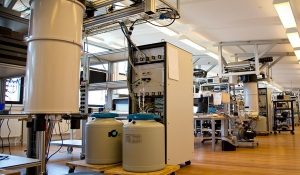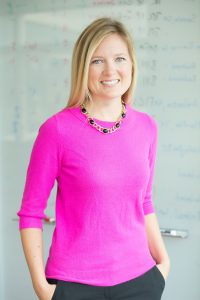Things to Come: Could the cloud and quantum computing help feed the world?
During the holiday season, many people around the world are busily planning some of their biggest and most meaningful meals of the year. But in many countries, hunger is a challenge all year-round, and over the next few decades, feeding our growing global population may become the biggest problem we’ve ever faced.
By 2050, the population of our blue planet will reach 9.5 billion, according to the United Nations. At the same time, climate change is costing billions of dollars in lost crops and livestock. And in the last 150 years, half the world’s topsoil has disappeared.
In light of all this, how will we feed ourselves?
All over the world, software developers, data scientists, agronomists and farmers are joining forces to address that question, using technology – and especially the cloud – to enhance food production, sometimes with very dramatic results.
The ‘agtech’ revolution
It doesn’t get a lot of headlines, but the fusion of agriculture and technology – “agtech” – is changing how food is created.
Drones equipped with infrared sensors monitor the health of crops and look for pest infestations; using Internet of Things (IoT) technology, sensors send real-time data from everything from oysters to cows to the cloud, where machine learning and artificial intelligence can check their health and discover more efficient ways to improve processes.
At Land O’ Lakes, a $13 billion agriculture company, an Azure-based application aggregates satellite data, weather data and agronomic research to help farmers make planting decisions.
With the HealthyCow24 application from SCR Dairy, farmers can “connect” their cows to the cloud, where the animals’ heart rate, temperature and rumination activity are analyzed. Then farmers like Steffen Hake in Germany can see the data on a real-time dashboard on their PC or mobile device.
With iBreedIT, an application running in Azure, breeders can accelerate the production of new varieties of plants – say, tomatoes with higher quantities of healthy antioxidants – reducing their time to market by half. And a set of cloud applications developed by the Rainforest Alliance tracks cocoa beans from harvest to table, ensuring that the cocoa was farmed sustainably.
But agtech, remarkable as it is, is just the beginning. Some truly enormous problems, staggering in their complexity, remain. If we can solve them, however, everything changes.
Take fertilizer.
A quantum improvement
Fertilizer, of course, is essential to agriculture and to improving crop yields. Ammonia is the basic ingredient of nearly all fertilizers, and to make it you simply mix nitrogen and hydrogen.
But to make this chemical reaction work, you need a catalyst, high pressure and temperature — an expensive operation called the “Haber-Bosch Process” that has changed little since its invention in 1910.
Scientists and engineers have been working for decades to improve this process by experimenting with different catalysts, but little progress has been made because there are so many possibilities – a nearly infinite number.
Sound like a job for a computer?
Yes, but finding the best catalyst would take – and this is no exaggeration – centuries or more on today’s fastest computers – and we don’t have that kind of time.
But what if you could determine a good catalyst in a matter of days?

Soon, you’ll be able to, with a “quantum computer,” a totally mind-bending machine that takes advantage of the fact that tiny particles like electrons can be in many states at once — not just a “one” or a “zero” but everything in between.
Today, even some elementary school students know that three binary bits in a traditional computer can store one number between 0 and 7. Amazingly, 300 “quantum bits,” or qubits, can store all numbers between 0 and 2300 simultaneously. In other words, 300 qubits store more information than there are atoms in the universe! With quantum computers, you can compute on all these values at the same time.
How is this possible? Through the magic of quantum physics, the crazy world of subatomic particles. If it seems hard to grasp, take heart. Even Nobel Prize-winning physicist Richard Feynman, who first imagined the concept of a quantum computer, was humbled by the complexity: “If you think you understand quantum mechanics, you don’t understand quantum mechanics,” he said.
In a nutshell, the quantum computer would allow you to more quickly and accurately analyze catalytic processes, and come up with the right answer.
Building the quantum computer: Anyons, anyone?
Microsoft has been involved in quantum computing since the late 1990s, when then-chief strategy officer Craig Mundie hired Fields Medal winner Michael Freedman and others to create Station Q, our quantum computing center in Santa Barbara, California. (If you’re not a mathematician, or you haven’t seen the movie Good Will Hunting, the Fields Medal is the mathematics equivalent of the Nobel Prize.)
Together with Alexei Kitaev, now professor of physics at Caltech, Freedman created the concept of the topological quantum computer. These devices don’t use “traditional” particles like electrons, but rather two-dimensional quasi-particles called “anyons.” These are formed into mathematical “braids” and “knots” and ultimately create computing logic gates.
Far out? You bet. The potential to open up amazing new solutions that benefit the planet? Absolutely. So much so that we’ve recently doubled down on our investment in quantum computing.

Quantum computing and the cloud: A perfect match
How will all this work? Well, to maintain the particles in a stable state, quantum computers must be chilled to near-absolute zero, and thus it’s not likely you’ll have one under your desk or in your data center.
Microsoft’s Azure cloud platform will provide a great way for quantum computing resources to be available “for rent,” thus providing their benefits to customers in the most economical fashion.
And under the direction of Krysta Svore, a Columbia PhD and computer scientist, Microsoft’s Quantum Architectures and Computation Group (QuArC) has created a free set of programming tools called LIQUi|> (pronounced “liquid”) that allow developers to simulate and program a quantum computer. “With LIQUi|〉, we can not only program a quantum computer, but also begin to educate the next generation of quantum computer scientists and put quantum circuits in the hands of potential users now,” Svore says.
That means we can start training the scientists and engineers who will be using quantum computers to solve not only the catalyst problem, but many others like it – with equally large impacts.
The future of food is bright
We must solve this problem – it is an imperative. According to the World Food Programme, one in nine people on our planet do not receive enough food to live a healthy, active life. But investment in agriculture reduces hunger by as much as 80 percent, according to the United Nations Food and Agriculture Organization.
So with remarkable technological advances fueled by the cloud, the Internet of Things and revolutionary new architectures like the quantum computer, perhaps – just perhaps – we can feed all of our people, all the days of the year.
A 40-year veteran of the software industry, Barry Briggs began programming on a Univac mainframe at NASA, worked on Lotus’ wildly popular spreadsheet program, 1-2-3, and served as CTO for Microsoft’s own IT organization, where he helped lead the company’s transition to the cloud.







